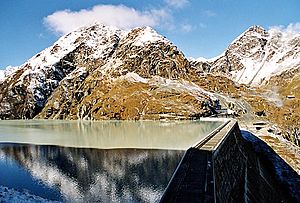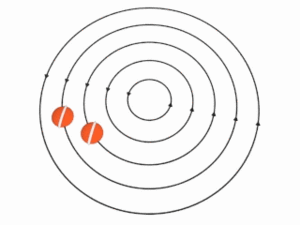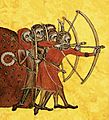Potential energy facts for kids


Potential energy is the stored or pent-up energy of an object. It is often contrasted with kinetic energy.
In physics, potential energy is the energy which an object has due to its position in a force field or which a system has due to the way its parts are arranged. Common types include the gravitational potential energy of an object that depends on its vertical position and mass, the elastic potential energy of an extended spring, and the electric potential energy of a charge in an electric field. The SI unit for energy is the joule (symbol J).
Potential energy is often associated with restoring forces such as a spring or the force of gravity. The action of stretching the spring or lifting the mass is performed by an external force that works against the force field of the potential. This work is stored in the force field, which is said to be stored as potential energy. If the external force is removed the force field acts on the body to perform the work as it moves the body back to the initial position, reducing the stretch of the spring or causing a body to fall. When this happens, potential energy changes into kinetic energy. The total energy stays the same because of the law of conservation of energy.
Physicists say that potential energy is the difference between the energy of an object in a given position and its energy at a reference position.
Contents
Simple examples
Bringing a rock uphill increases its potential energy under gravity. Stretching a rubber band increases its elastic potential energy, which is a form of electric potential energy. A mixture of a fuel and an oxidant has a chemical potential energy, which is another form of electric potential energy. Batteries too have chemical potential energy.
Types of potential energy
There are various types of potential energy, each associated with a particular type of force.
Gravitational potential energy
Gravitational potential energy is experienced by an object when height and mass is a factor in the system. Gravitational potential energy causes objects to move towards each other. If an object is lifted a certain distance from the surface from the Earth, the force experienced is caused by weight and height.
Electric potential energy
Electric potential energy is experienced by charges both different and alike, as they repel or attract each other. Charges can either be positive (+) or negative (-), where opposite charges attract and similar charges repel. If two charges were placed a certain distance away from each other, the potential energy stored between the charges can be calculated by:
Elastic potential energy
Elastic potential energy is experienced when a rubbery material is pulled away or pushed together. A spring for example stores elastic potential energy. The amount of potential energy the material has depends on the distance pulled or pushed. The longer the distance pushed, the greater the elastic potential energy the material has. If a material is pulled or pushed, the potential energy can be calculated by:
Related pages
Images for kids
-
A trebuchet uses the gravitational potential energy of the counterweight to throw projectiles over two hundred meters
-
Springs are used for storing elastic potential energy
-
Archery is one of humankind's oldest applications of elastic potential energy
-
Gravitational force keeps the planets in orbit around the Sun
-
Plasma formed inside a gas filled sphere
See also
 In Spanish: Energía potencial para niños
In Spanish: Energía potencial para niños






